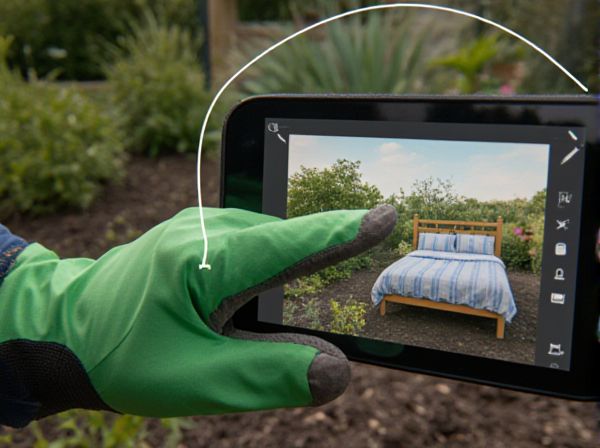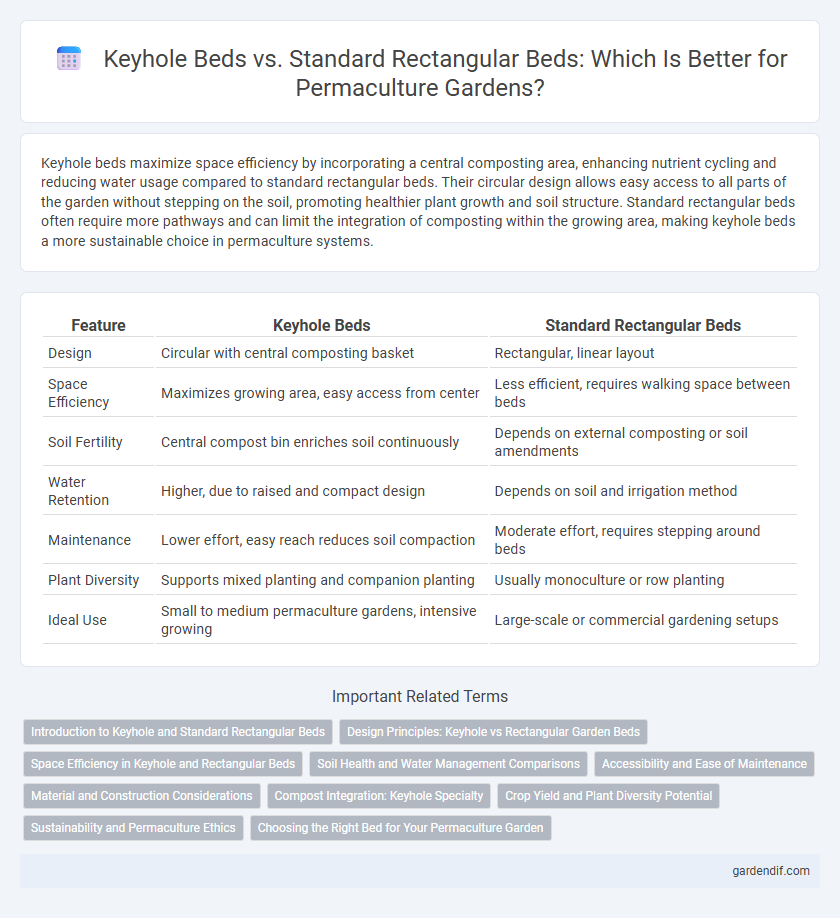
Keyhole beds vs standard rectangular beds Illustration
Keyhole beds maximize space efficiency by incorporating a central composting area, enhancing nutrient cycling and reducing water usage compared to standard rectangular beds. Their circular design allows easy access to all parts of the garden without stepping on the soil, promoting healthier plant growth and soil structure. Standard rectangular beds often require more pathways and can limit the integration of composting within the growing area, making keyhole beds a more sustainable choice in permaculture systems.
Table of Comparison
| Feature | Keyhole Beds | Standard Rectangular Beds |
|---|---|---|
| Design | Circular with central composting basket | Rectangular, linear layout |
| Space Efficiency | Maximizes growing area, easy access from center | Less efficient, requires walking space between beds |
| Soil Fertility | Central compost bin enriches soil continuously | Depends on external composting or soil amendments |
| Water Retention | Higher, due to raised and compact design | Depends on soil and irrigation method |
| Maintenance | Lower effort, easy reach reduces soil compaction | Moderate effort, requires stepping around beds |
| Plant Diversity | Supports mixed planting and companion planting | Usually monoculture or row planting |
| Ideal Use | Small to medium permaculture gardens, intensive growing | Large-scale or commercial gardening setups |
Introduction to Keyhole and Standard Rectangular Beds
Keyhole beds feature a circular or square design with a central composting basket, maximizing space efficiency and nutrient cycling by allowing easy access to all parts of the bed from a single path. Standard rectangular beds offer straightforward construction and planting layouts, providing simplicity and compatibility with traditional gardening tools. Both designs support permaculture principles, but keyhole beds enhance soil fertility and water retention through integrated composting and minimized foot traffic.
Design Principles: Keyhole vs Rectangular Garden Beds
Keyhole beds maximize space efficiency and accessibility by incorporating a central path that allows gardeners to reach all plants without stepping on the soil, promoting soil health and reducing compaction. Their circular design supports diverse plant layering and microclimates, enhancing biodiversity and water retention compared to standard rectangular beds. In contrast, rectangular beds prioritize simplicity and ease of construction but may limit ergonomic access and soil management flexibility inherent in keyhole designs.
Space Efficiency in Keyhole and Rectangular Beds
Keyhole beds maximize space efficiency by allowing gardeners to access a larger growing area from a compact central path, reducing wasted space compared to standard rectangular beds with separate walkways. The circular design of keyhole beds increases planting area per square foot and improves soil management through easier compost integration at the core. Rectangular beds typically require more aisle space for access, decreasing overall planting density and lessening efficient use of garden space.
Soil Health and Water Management Comparisons
Keyhole beds maximize soil health by enabling easy access to a central composting basket, promoting nutrient-rich soil and improved microbial activity. These beds optimize water management through their circular design, which minimizes runoff and enhances water infiltration compared to standard rectangular beds. Enhanced aeration and moisture retention in keyhole beds support sustainable plant growth and reduce water usage effectively.
Accessibility and Ease of Maintenance
Keyhole beds offer superior accessibility by featuring a central path that allows gardeners to easily reach all areas without stepping on the soil, promoting healthier plant growth. The circular design of keyhole beds minimizes bending and stretching, reducing physical strain and simplifying maintenance tasks like watering and harvesting. In contrast, standard rectangular beds often require longer reaches and more movement around the bed edges, which can lead to soil compaction and increased effort during upkeep.
Material and Construction Considerations
Keyhole beds utilize a circular design with central composting access, often constructed from reclaimed wood, stone, or bricks to create durable, heat-retentive walls that enhance soil fertility. Standard rectangular beds typically use wood, metal, or plastic frames and require straightforward construction with less emphasis on thermal mass or nutrient cycling. Material choice in keyhole beds prioritizes organic decomposition and longevity, whereas rectangular beds focus on ease of assembly and space efficiency.
Compost Integration: Keyhole Specialty
Keyhole beds offer a unique advantage in compost integration by centralizing compost within the garden bed, allowing nutrients to disperse evenly and efficiently to plants. Unlike standard rectangular beds, which require separate composting areas or surface application, keyhole beds feature an accessible compost basket at the core, enhancing soil fertility and moisture retention. This design minimizes nutrient runoff and supports continuous organic matter recycling directly at the root zone.
Crop Yield and Plant Diversity Potential
Keyhole beds maximize crop yield by improving access to dense planting areas and facilitating efficient water and nutrient distribution, resulting in higher productivity per square foot compared to standard rectangular beds. Their unique design allows for increased plant diversity by enabling gardeners to incorporate multiple microclimates and companion planting strategies within a compact footprint. In contrast, standard rectangular beds often limit planting density and diversity due to less efficient space utilization and accessibility.
Sustainability and Permaculture Ethics
Keyhole beds optimize space and resource efficiency by allowing easy access to the center, minimizing soil compaction and water runoff, which aligns with permaculture principles of care for the earth and water conservation. Their circular design facilitates diverse planting layers and composting in situ, enhancing soil fertility and biodiversity compared to standard rectangular beds. This sustainable layout promotes ethical land use by supporting ecosystem health and reducing the need for external inputs.
Choosing the Right Bed for Your Permaculture Garden
Keyhole beds offer enhanced accessibility and efficient space utilization, making them ideal for intensive vegetable production in permaculture gardens. Standard rectangular beds provide straightforward construction and flexibility for crop rotation, supporting diverse planting strategies and expansion. Selecting the right bed depends on garden size, crop types, and maintenance preferences, optimizing productivity and sustainability.
Keyhole beds vs standard rectangular beds Infographic

 gardendif.com
gardendif.com